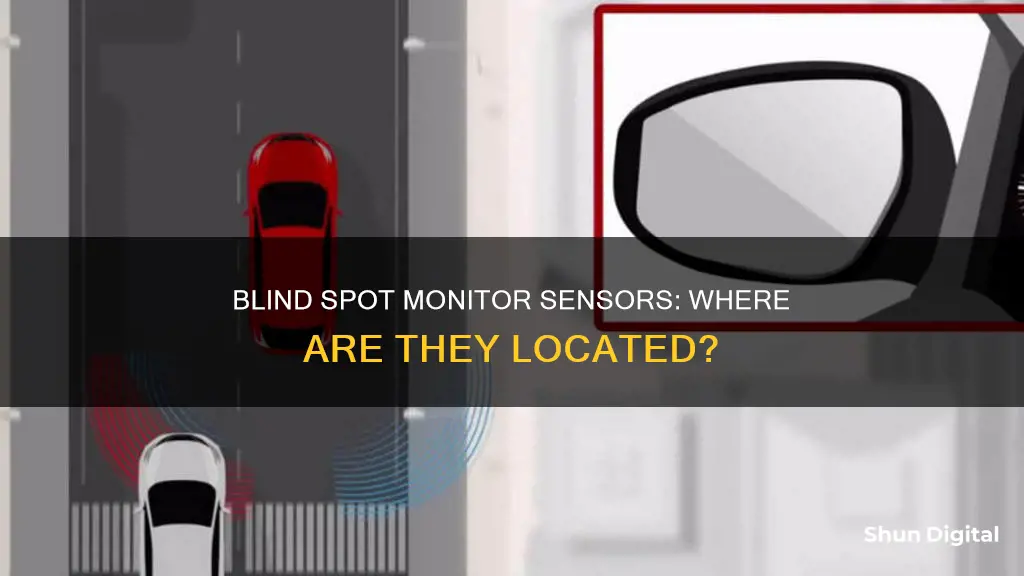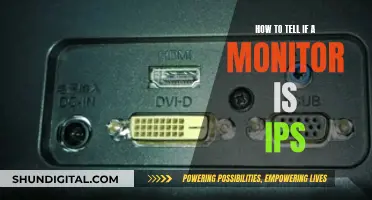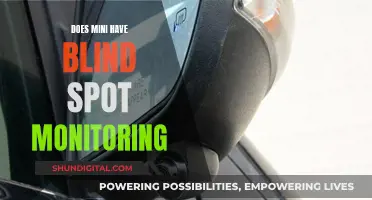
Blind spot monitor sensors are usually located on the sides of a car, often in the vicinity of the external rear-view mirrors or near the rear bumpers. They can also be placed in the door mirror housings or the side-view mirrors themselves. These sensors use ultrasonic or radar technology to detect vehicles, bikes, and other objects in a car's blind spots, providing drivers with visual, audible, vibrating, or tactile warnings.
| Characteristics | Values |
|---|---|
| Type of system | Active or passive |
| Location of sensors | Sides of the car, near external rear-view mirrors or rear bumpers |
| Type of sensors | Electronic detection devices |
| Type of signals emitted | Electromagnetic waves or computer-processed images |
| Type of alerts | Visual, audible, vibrating or tactile |
| Additional features | Rear Cross-Traffic Alert |
What You'll Learn

Active vs. passive blind spot monitoring systems
Blind spot monitoring systems are an essential safety feature, helping to prevent accidents and keep drivers aware of their surroundings. While the exact placement of blind spot sensors varies depending on the vehicle and manufacturer, they are typically located on the sides of the car, near the external rear-view mirrors or close to the rear bumpers.
Now, when it comes to active versus passive blind spot monitoring systems, there are some key differences to note:
Passive Blind Spot Monitoring Systems:
Passive systems are more low-tech solutions that rely on the use of special convex mirrors. These mirrors are added to the external rear-view mirrors, allowing drivers to see into areas that standard mirrors cannot. The advantage of these systems is that they are inexpensive and highly effective, often preferred by consumers due to their simplicity and lack of annoying warning lights or beeping noises.
Active Blind Spot Monitoring Systems:
Active systems, on the other hand, employ electronic detection devices that use radar, cameras, or other sensors to monitor the vehicle's blind spots. When another vehicle enters the blind spot, the system alerts the driver through visual, audible, or tactile notifications. These warnings can include flashing lights, buzzing sounds, or vibrations in the steering wheel or driver's seat. In some advanced systems, the car may even intervene by steering back into the previous lane or applying brakes to avoid a potential collision.
While active systems provide more sophisticated warnings, they are typically more expensive and may be offered as optional upgrades by automakers. However, prices for these systems are dropping, and they are becoming more widely available.
Both active and passive systems have their advantages, and the right choice depends on personal preference, budget, and the specific features offered by different automakers. Ultimately, any safety upgrade can dramatically reduce the risk of accidents, making driving safer for everyone on the road.
Best Places to Buy Finger Oxygen Monitors
You may want to see also

Visual, audible, vibrating, or tactile warnings
Blind spot monitoring systems can provide drivers with visual, audible, vibrating, or tactile warnings when there is a vehicle in their blind spot. Visual alerts are often in the driver's peripheral vision, such as indicators placed in the side mirror glass or on the A-pillar inside the vehicle. These indicators light up when a vehicle is in the blind spot and start flashing if the driver indicates to turn. If the driver's turn signal is off, the indicators glow steadily without flashing.
Audible alerts are usually used in conjunction with visual alerts and are triggered when the driver indicates to turn while there is a vehicle in their blind spot.
Vibrating or tactile warnings are less common, but some luxury car brands, like BMW, offer this feature, vibrating the steering wheel if the driver tries to make an unsafe lane change.
Blind spot monitoring systems are designed to enhance driver safety and reduce accidents by providing warnings through a variety of sensory cues.
Finding a VESA Monitor: Compatibility and Ease of Use
You may want to see also

Rear cross-traffic alerts
The rear cross-traffic alert system uses sensors, typically located at each side of the vehicle near the rear bumper, to scan for approaching vehicles, obstacles, or people. These sensors can utilise radar or ultrasonic waves to detect objects within a range of approximately 15 to 30 feet beyond the bumper. This wide monitoring area significantly enhances the driver's awareness of their surroundings, enabling them to make safer decisions while reversing.
When the system detects an approaching vehicle or obstacle, it provides both visual and auditory warnings to the driver. These warnings can include flashing LED indicators on the dashboard, rearview mirror, or side mirror, depending on the direction of the potential hazard. Additionally, a buzzing or chiming sound may accompany the visual alerts to further emphasise the presence of a potential hazard.
It is important to note that rear cross-traffic alert systems have certain limitations. They may not be effective in detecting small objects, such as motorcycles, bicycles, or pedestrians. Additionally, the system may fail to detect vehicles approaching directly from behind or moving away from the vehicle. Moreover, these systems often work best in straight parking situations and may have reduced effectiveness in angled parking spots.
To ensure optimal performance of the rear cross-traffic alert system, it is recommended to maintain a slow speed while reversing. This allows the system to accurately detect objects within its speed range, typically between 3 and 20 miles per hour. Additionally, it is crucial to regularly check the sensors for any obstructions, as a blocked sensor can impair the functionality of the system.
Finding the Perfect Monitor Arm: A Guide
You may want to see also

Radar vs. camera sensors
Blind spot monitoring systems can be categorised into two types: active and passive. Active blind spot monitoring systems use electronic detection devices mounted on the sides of the car, usually near the external rear-view mirrors or rear bumpers. These devices either emit electromagnetic waves (usually radar) or take computer-processed images with a digital camera. When the system detects another vehicle in the blind spot, it alerts the driver using flashing lights, audible sounds, or both. Some advanced systems may even attempt to steer the car back into its lane.
Radar-based systems use electromagnetic waves that bounce off solid objects and return an echo, indicating their presence. These systems are often mounted at the rear of the car, near the back bumpers, and can detect vehicles in the blind spot as well as fast-approaching vehicles. On the other hand, camera-based systems use computer-processed images from cameras placed in the side-view mirrors or door mirror housings to detect vehicles in the blind spot.
Passive blind spot monitoring systems, on the other hand, use mirrors to detect blind spots. Many car manufacturers offer the option of installing a special convex mirror in the corner of the external rear-view mirror, providing a wider field of view. While these mirror-based systems are the cheapest form of blind spot monitoring, they have been shown to be as effective as radar-based systems and are preferred by some drivers due to their simplicity and lack of annoying warning lights or sounds.
Aftermarket blind spot monitoring systems are also available for older vehicles that lack built-in technology. These systems typically use sensors based on sonar, radar, or lidar to detect hazards and trigger an indicator, such as an LED light or alarm, when something enters the vehicle's blind spot.
Monitoring Employee Internet Usage: Ethical or Necessary?
You may want to see also

Blind spot intervention
The BSI system uses radar sensors or cameras mounted on the sides of the car, often near the external rearview mirrors or rear bumpers. When the system detects another vehicle in the blind spot, it alerts the driver through visual, audible, or tactile notifications. These alerts can include flashing lights in the driver's peripheral vision, beeping sounds, or vibrations.
Some vehicles, such as the Infiniti, take blind spot intervention a step further. In addition to providing alerts, the Infiniti BSI system actively intervenes by gently applying the brakes on the side of the car away from the detected obstacle, causing the vehicle to swerve back towards the safe lane. This countersteering capability was first introduced by Nissan in 2010 with the Nissan Fuga/Infiniti M model.
Is Your Monitor Bluetooth-Enabled? Here's How to Tell
You may want to see also
Frequently asked questions
The blind spot monitor sensors are typically located on the right and left sides of the car's rear bumper.
Blind spot monitor sensors detect vehicles in a driver's blind spot, alerting them through visual or audio cues.
Visual alerts include flashing lights in the driver's peripheral vision, such as in the side-view mirror or on the A-pillar inside the vehicle.
Audio alerts include beeping sounds when a driver signals a lane change, warning them of a vehicle in their blind spot.
Yes, blind spot monitoring systems can be categorised as either active or passive. Active systems use electronic detection devices, while passive systems use mirrors to help drivers see into their blind spots.







